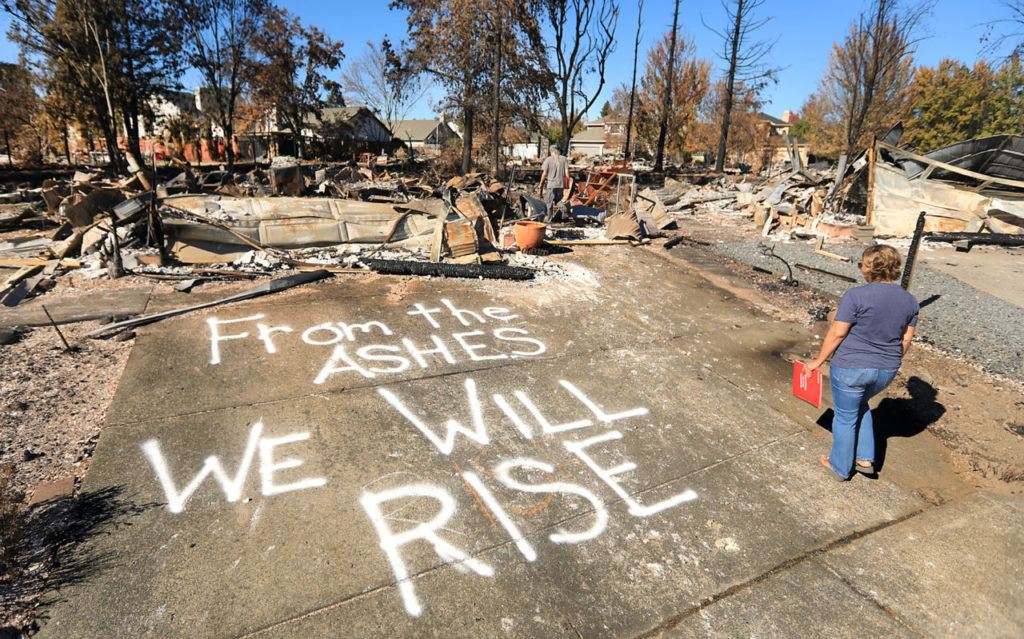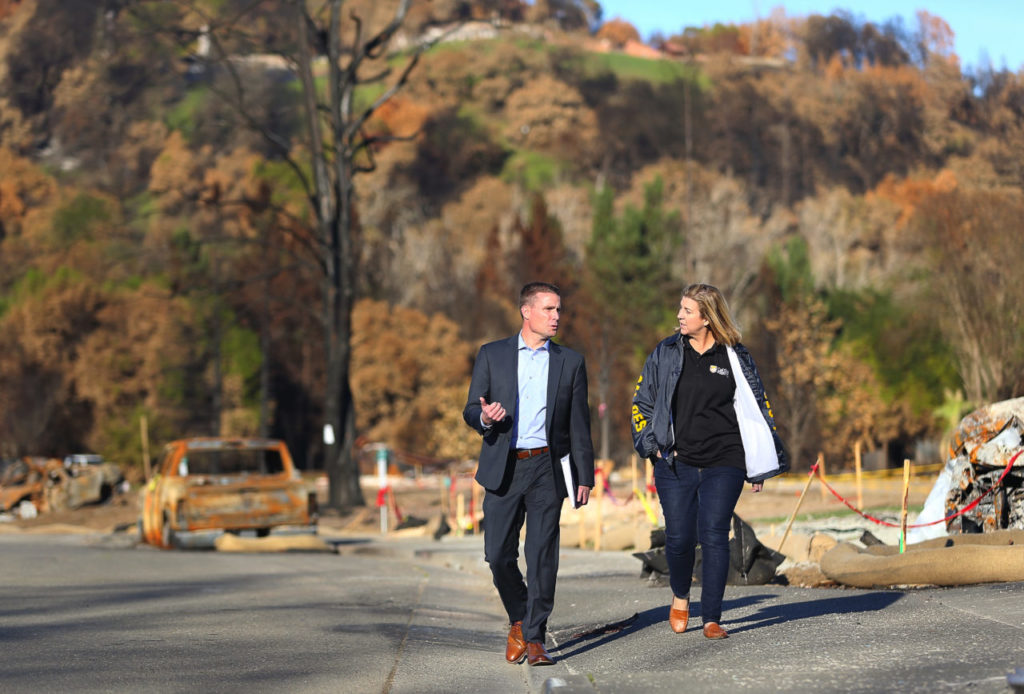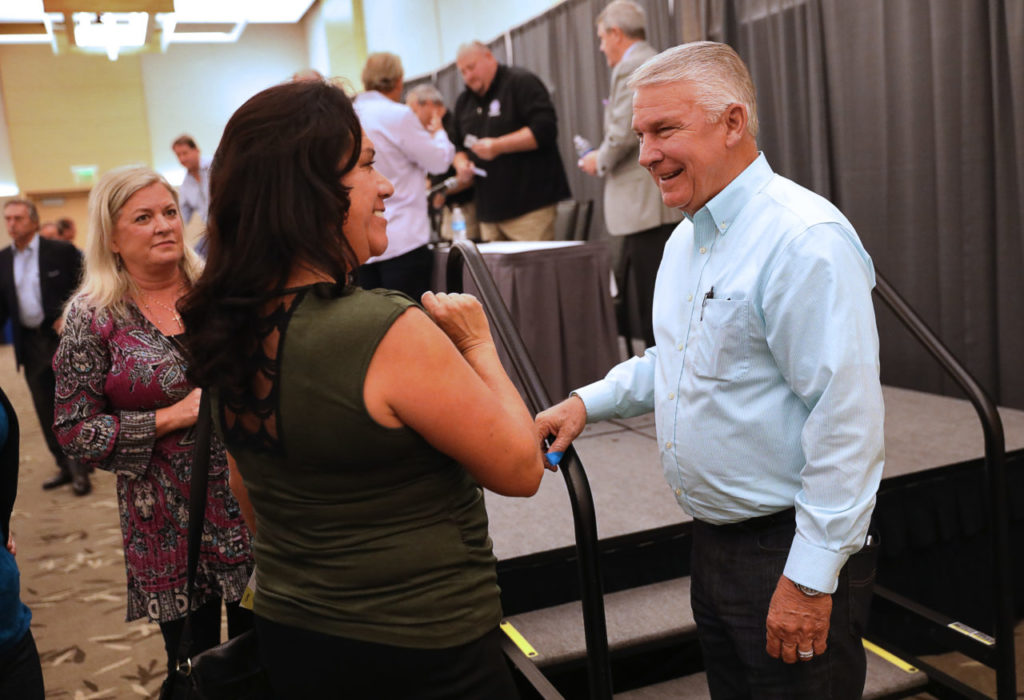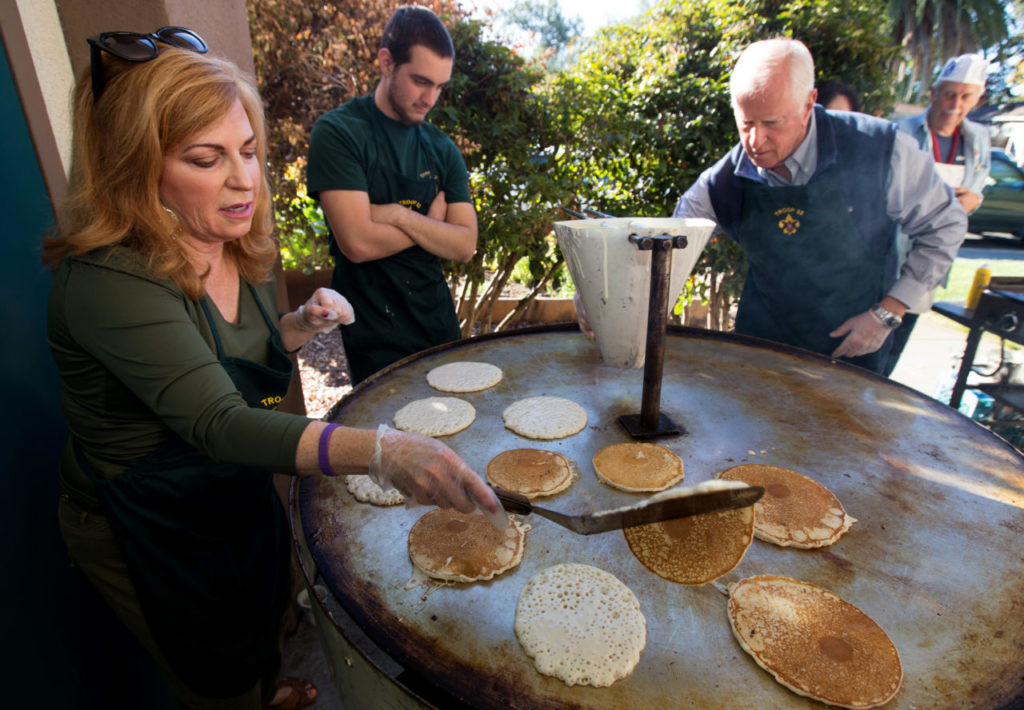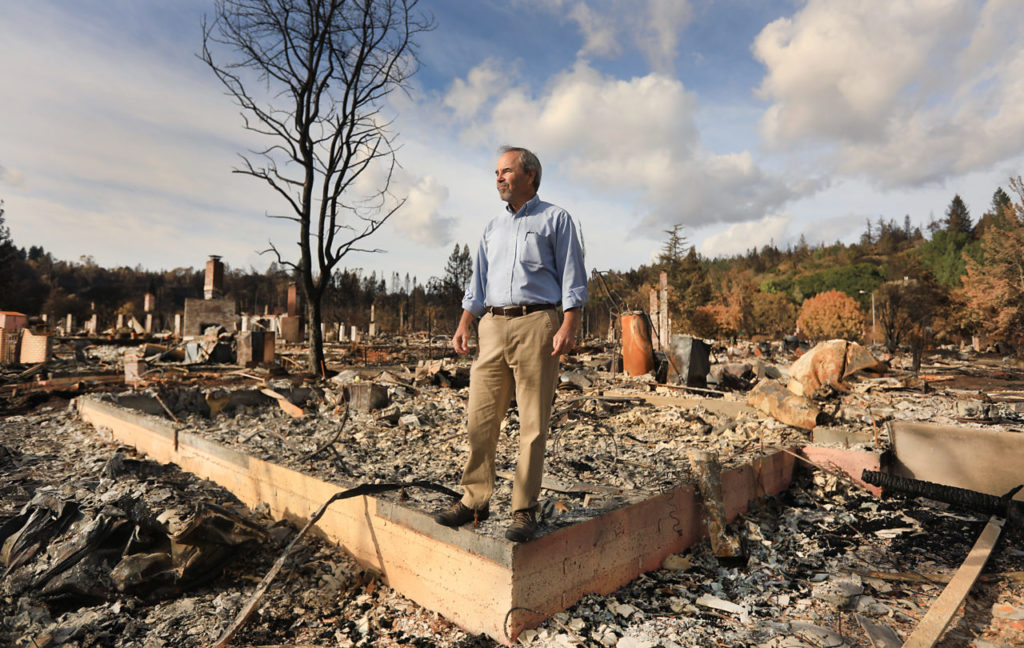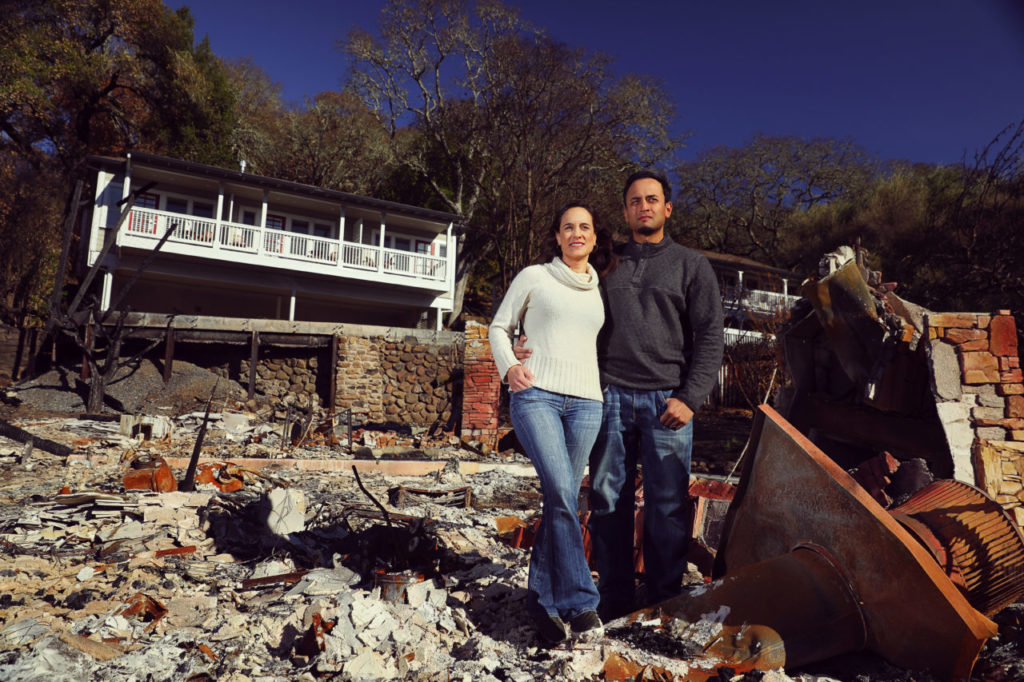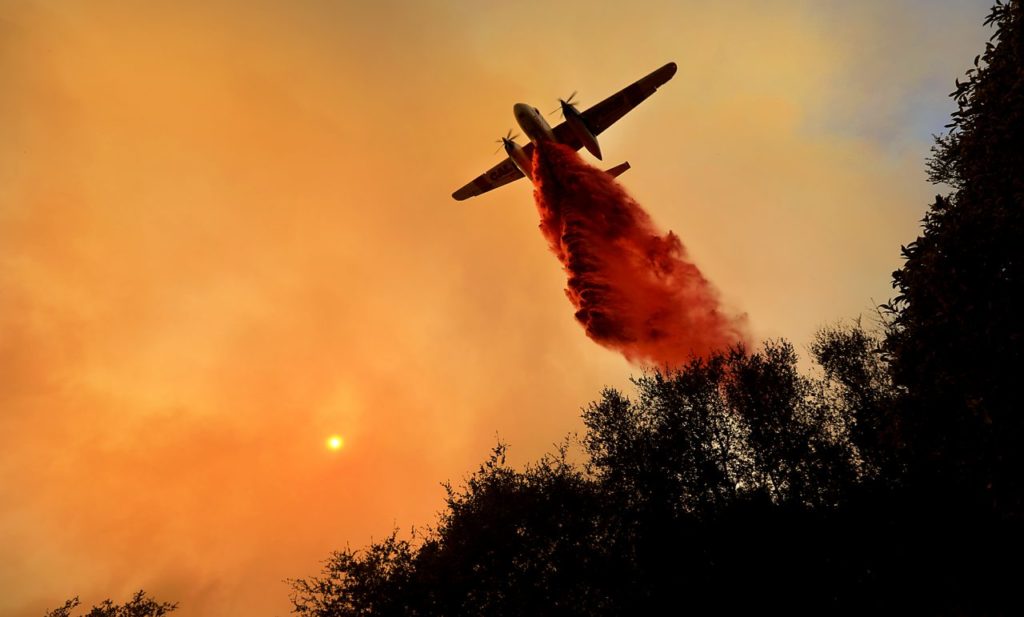Weeks after flames roared down into Sonoma County from the east and laid waste to northern Santa Rosa, scorched cars still littered Coffey Park’s streets and driveways, many framed by puddles of aluminum from melted rims and engine blocks. They were remnants of a neighborhood that once hummed with activity — block parties on holidays, basketball games in the street — nearly all of it reduced to ash, twisted metal and buckled masonry over several terrifying hours in early October.
More than 5,100 Sonoma County homes were destroyed in the unprecedented firestorm, which burned on in three major blazes over three weeks. The deadliest and most destructive, the Tubbs fire, claimed 1,347 Coffey Park homes, leaving a relentless gray, umber and black moonscape broken only by the occasional surviving conifer, the even rarer green lawn.
Still, this devastated neighborhood on the western extent of the Tubbs fire represents a frontline in a comeback that began in earnest just a month later. Dump trucks and excavators rumbled into the area and cleanup crews have been at work ever since, day and night, readying the burned lots for whatever lies ahead.
For Tom and Michelle Tantarelli, whose Miller Drive home in Coffey Park burned, along with all the others on their block, there is no question: They plan to rebuild.
“We’ve been in this home for 39 years,” said Michelle Tantarelli, a registered nurse. “But you can’t look back on what you lost. You can’t dwell on it. You have to move forward, and build a new life and new memories.”
The path ahead for thousands of other fire survivors in Sonoma County is not so evident or straightforward. The fires exploded out of the early morning darkness and left rubble, tears and so much uncertainty in their wake. They inspired true heroism and generous philanthropy, but they were deeply traumatizing, killing at least 44 people across Northern California — including 24 in Sonoma County — and inflicting emotional wounds that will be as challenging to address as the profound economic upheaval and staggering financial losses, estimated at more than $7.5 billion.
“Our grandkids were visiting, and we got out of here with them and the clothes on our backs. That’s it,” said Tom Tantarelli, a retired Sonoma County sheriff’s deputy. Five residents of the Coffey Park area were killed in the fire. “Something like this, it strips you down. It makes you humble.”
The region’s pre-existing housing crisis, the disparate reimbursement rates provided by insurers to affected homeowners and the heavy blow to the local economy, including hundreds of job losses, will influence who decides to stay, whether they rebuild and how quickly they do so, disaster experts say.
“You’re going to see some people leave the area simply because their insurance won’t cover the cost of rebuilding. That seems very likely,” said James Lee Witt, who served as director of the Federal Emergency Management Agency under President Bill Clinton and was brought into the area by Rebuild North Bay, a new group seeking to assist with the recovery.
About 90 percent of owners who lost homes during the fires, including the Tantarellis, signed on with the federal government to clean up their properties. That enrollment indicates a strong regional intent to persevere and move forward quickly with the work, which federal officials say could wrap up early this year. By December, crews contracted by the U.S. Army Corps of Engineers had cleared about 900 burned home sites, leaving thousands more to go in Santa Rosa’s Coffey Park and Fountaingrove neighborhoods, as well as fire-ravaged Larkfield-Wikiup to the north and Sonoma Valley to the south.
For-sale signs on burned properties have already popped up in many of those areas, where residents are confronting construction logistics and timelines defined not only by their insurance policies and financial wherewithal but the availability of help — engineers, architects, contractors — and potential payoff once a home is complete. It will be worthwhile to many in the prime of their lives, a lost cause for others.
On Miller Drive, at least, the consensus seems clear.
“I’ve talked to about 10 of my neighbors,” Tom Tantarelli said. “Only one of them isn’t going to rebuild. This neighborhood means a lot to people. The neighbors mean a lot to each other.” n his three short years in the state Legislature, Sen. Mike McGuire, D-Healdsburg, has seen vast swaths of his North Coast district consumed in five blazes that are now among the top 20 most destructive wildfires in California history. The list is topped by the Tubbs fire, and includes three others that burned across Sonoma
Valley and Napa and Mendocino counties in October. The North Bay fires destroyed more than 8,500 structures, including 6,200 homes. Including the deadly Valley I fire in Lake County in 2015, the five major fires torched 400 square miles, eight times the size of San Francisco.
McGuire’s experience in Lake County, where major fires have rampaged every year since 2015, has convinced him that a quick cleanup is an essential first priority to a full recovery.
“Second, we have to transition people who lost their homes, especially families and seniors, from temporary shelter into long-term housing. That means any and all options — apartments subsidized by state and federal agencies, modular homes, fifth-wheel trailers — everything. This is probably our greatest immediate challenge. The housing market in the North Bay was one of the tightest in the country before the fires, and the disaster just exacerbated a situation that was already critical.”
The costs for local governments — in lost property taxes from destroyed homes and businesses — is likely to run into the tens of millions of dollars, he said, straining what’s available to maintain public services, repave roads and pay for police and fire protection.
“Right after the fires started, the Governor’s Office made a commitment that no need will go unmet, that the North Bay will get all required resources,” he said. “But we also need federal help.”
That was clear to Witt, the former FEMA director, whose tour of the fire zone in Santa Rosa revealed ruin almost without parallel in his long career, including 350 federally declared disasters, from floods and hurricanes to wildfires and earthquakes.
“It’s one of the worst I’ve seen,” Witt said, noting the scope of physical damage and financial loss weren’t the only factors contributing to Sonoma County’s woes.
“It’s also the way it happened, the speed of the fires, the fact that people were forced from their homes at night and lost everything in seconds,” Witt said. “It’s devastating.”
Rebuild North Bay was formed by civic and business leaders, including Sonoma-based developer and lobbyist Darius Anderson, managing member of Sonoma Media Investments, which owns Sonoma Magazine. He drove Witt around after the fires and drafted him to help bolster and speed the recovery.
“We want to get our lives back to normal, so it’s essential that we move efficiently and as rapidly as possible. But we have to take the time to rebuild smarter, safer, and greener,” said Anderson.
“We started Rebuild North Bay because we knew we were going to need a coalition, a strong coalition to get things done,” he said. “We knew we had to get everyone on board — business, civic and labor leaders, farmers, builders, environmentalists, neighborhood groups.”
The first thing county residents must remember, Witt said, “is that recovery won’t happen overnight. Full recovery from the 1994 Northridge earthquake in Southern California took 15 years. New Orleans is 10 years and counting into rebuilding from Katrina. For Sonoma County, I think it’ll take at least five years for a substantive recovery.”
The most dangerous time for disaster victims can be from six months to a year after the event, he said.
“People go through a few weeks of initial shock, then they’re motivated by a determination to reclaim their lives,” Witt said. “And after that they get actively engaged in lining everything up, trying to rebuild their homes, get on with their lives. But they find they’re hampered when they try to replace all their lost paperwork, and when they deal with insurance companies and government officials. And then the frustration
builds, and ultimately, the anger. You have to keep reminding yourself that it’s going to take time — more time and effort than you think.” a couple of blocks from the Tantarellis, Alice and Ron Daley combed through the ashes of his brother’s rented Coffey Park home. It was late A October, and they were hoping to find something salvageable. They didn’t have much luck.
“My brother lost everything,” said Ron Daley, of Forestville. “A $20,000 motorcycle, his really valuable firearms and comics collections. Everything. I came out here when everything was going up to try to save some stuff. I have neuropathy and don’t have much sensation in my feet, and my nephew said, ‘Hey your shoes are burning.’ We had to get out.”
Daley kicked a metal ammo can that looked like a sieve from bullet perforations. It had been full of 9 mm pistol ammo that had cooked off in the flames.
“Maybe in 10 years this place will look like it was,” Daley said. “But a lot of people aren’t coming back here, especially renters like my brother. A lot of people here were struggling just to stay in the middle class. They didn’t have many options before the fire, and they have fewer now.”
Sonoma County Supervisor Shirlee Zane agrees that for residents on the lower rungs of the economic ladder, the fires have delivered a blow that likely leaves many now hanging on by their fingertips.
The disaster took out 5 percent of Santa Rosa’s housing stock, and the fires followed three years of rock-bottom rental vacancy rates in the county. Last year, median home prices soared well above the pre-recession peak. All that means the housing emergency sparked in October is far from over, Zane said.
“We’re still in flux.
We don’t know who will or can stay, what the commitment of the feds and states ultimately will be, whether the bankers and developers are willing to take some risks,” Zane said. “Meanwhile, we’re losing people — valuable people, the people who support this community, who work in the vineyards and the hospitality and service industries.”
An effort on the order of the Manhattan Project — responsible for crafting the first nuclear weapons — is needed to respond to crisis, she said “We have to do it all — expedite rebuilding and approve new developments,” Zane said. “That doesn’t mean intruding on green space or urban boundaries. We have to build density — build up, not out — and we have to do it fast. Our population is aging, and we can’t afford to lose our workforce. Our economy is making huge gains, especially in the tourism sector, but we need to provide housing for the people who are doing the work.”
It figures to be a heavy lift for everyone involved: local, state and federal government, relief funds and organizations, the builders who are now laying out ambitious plans for Coffey Park and Fountaingrove, and coordinating groups like Rebuild North Bay.
“We have to build back with reasonable expectations about both time scale and equity recovery,” Witt said in early December. “Yes, it’s going to be expensive.
We also have to ensure that people have the means to fill the gaps left by insurance shortfalls — through HUD, Fannie Mae, and any other available means. While FEMA recently received disaster funding, nothing has been specifically earmarked for wildfires. But our team is working on that, and I do think we’ll see those appropriations.”
O nly one other Santa Rosa neighborhood lost more homes than Coffey Park, and that was in the upscale subdivisions of Fountaingrove. Home to many of the county’s business executives, physicians and government leaders, the forested hillsides and ridges were developed over the past three decades on what is now the city’s northeastern boundary. The last major wildfire in the county, the 1964 Hanly fire, burned through Fountaingrove when it was mostly ranchland. This time, flames incinerated 1,519 homes and killed two residents, including Tak-Fu Hung, 101, the oldest person to die in the fires.
Indra Chaliha, a Kaiser Permanente pediatrician, lost her Sedgemoore Drive home to the blaze. She was one of the more than 200 doctors burned out by the fires. Seventy were fellow Kaiser doctors.
“I’ve only been living here for two-and-a-half years, so I still owe the bank,” said Chaliha, surveying the blackened foundation of her home. “If I rebuild, I’ll ultimately regain a lot of my equity, but if I sell as is, I lose it. So for me, the choice is clear.”
Chaliha expects to run a fairly long and arduous gauntlet of permitting and construction hassles, but she hopes to be back in her new home with her young daughter by the summer of 2019. The two fled in her car just ahead of the flames at 2:15 a.m., saving little but their passports.
“My father came to this country from India at 17. He studied, and he became an electrical engineer. He always told me that knowledge is everything, education is power — that it doesn’t matter if you lose material things. His memory, the things he said, are a source of strength for me now.”
Some of her Fountaingrove neighbors won’t be rebuilding, Chaliha said — particularly elderly residents who feel ill-prepared to negotiate the red tape or disinclined to start anew.
Mike Agil, a developer in his 50s, is considering walking away from his property on Bristlecone Court. Agil says he feels confounded by the governmentmanaged cleanup process. He contends it allows private companies contracted for the work to charge inflated prices, which come out of homeowner insurance.
“Don’t tell me about cleanup costs,” Agil said. “I know — I’m a developer. A lot of these foundations could be salvaged, which would really reduce rebuilding costs and expedite construction. But the agencies all insist that they [the foundations] have to go. It’s been crazy. They drag their feet, they obstruct, they don’t respond. I could get a crew in here and clean up this property right now. The city has my plan on file. They could quickly amend it for green updates, stamp it, and I could start building immediately. But that won’t happen. Even under the best scenario, this lot will still be bare in two years. So I’m thinking really hard about putting up a ‘for sale’ sign and walking away.”
Local building officials and experts hired by the city of Santa Rosa have concluded that the temperatures and duration of the firestorms that ravaged Sonoma County make any surviving foundations unsalvageable. K But Santa Rosa Mayor Chris Coursey said he understands the general frustration.
He’s been feeling it himself in an ever-pressing list of needs, questions and tasks since he was roused from sleep at 2 a.m. October 9 by City Manager Sean McGlynn and asked to issue an emergency declaration.
“I’ve been talking to stressed people every day,” Coursey said in mid-November. “Some are depressed, others are yelling or crying. All of them have good and legitimate reasons for their responses, but we can’t deal with the 3,000 homes that were lost on a case-by-case basis if we’re going to get anywhere. I have to think of what’s best for the city as a whole.” eith Woods is a quick-witted, voluble spokesman for the local construction industry. In his time, he has seen market crashes send building activity into freefall and boomlets that translated to hundreds more high-paying jobs in the trades. But he has never seen anything like the landscape now facing contractors.
“The latest estimate I heard is that we’ll need 19,000 construction workers to do what needs to be done. And not only do we have to develop this workforce — we have to find places to house the workers. That’s going to be incredibly challenging, given the housing shortages we’re facing,” said Woods, CEO of the North Coast Builders Exchange, a trade group.
For those intent on rebuilding, “finding or choosing housing plans and hiring architects and contractors will take a lot of time and effort,” Woods said. Unlicensed contractors and potential scams are other perils, he said.
“If you can rebuild your home in less than 24 months you should pop some champagne and celebrate. For most people, it will take two to three years to rebuild, and for others, three to five years.”
In the Larkfield-Wikiup and Mark West area north of Santa Rosa, the challenge is plain to see. The Tubbs fire wiped out whole neighborhoods at Larkfield’s crossroads entrance after churning for miles along the area’s rural roadways to the east, claiming 1,500 homes in the sprawling Rincon Valley Fire District.
“It’s still horrible, having to see what the fires did here,” said Joanne Martensen, the owner of Bon Appetit Gift & Card at Larkfield Center. The little shopping complex escaped largely unscathed from the flames, but it’s surrounded by a wasteland of burned-out homes and apartment complexes.
“We were closed for 10 days during the fires, but people started coming in as soon as we opened back up,” Martensen said.
The store is one of many cherished shops and restaurants countywide that survived the flames, offering residents a gathering place to reestablish routines and connections that lie at the heart of civic life, that speak of community and continuity.
“My customers tend to be very local. We know them, they know us,” said Martensen. “People want to talk about their experiences, but they also want to see if we still carry items they bought for their old homes, so they can have them when they rebuild. More than one customer told me they just wanted to come in because this was their happy place, they feel at home here. It’s familiar. It gets very emotional at times, but it feels good, it feels that we’re all in this together.” similar atmosphere of solidarity prevails in the Sonoma Valley, where the Nuns fire scorched more than 500 homes.
“When we finally opened up on a Monday almost two weeks after the fires started, we had a limited menu,” said Kristopher Dalton, the general manager of Glen Ellen Star, one of the valley’s most popular restaurants. “But the response was overwhelming. Every seat was filled by 6 that first night. Once people discovered that we were going to reopen, they showed up in force. They wanted to support us, and they wanted to be with each other.”
Sia Patel, who owns the small and elegant Olea Hotel in Glen Ellen with her husband, Ashish Patel, agrees with Dalton that people in valley are mutually supportive and remain generally upbeat. Though the hotel sustained partial damage and is closed, Patel said she is grateful that her home was spared. As for when the couple will reopen the Olea — that’s still up in the air.
“The whole hillside behind us burned,” Patel said. “It’s not our property, and we’re not sure who will pay for the cleanup, or when it will occur. In fact, almost everything around us burned, and that’s sure to have a negative effect on business, at least in the short term. The visual impacts are real, and there’s going to be a lot of noisy construction for quite a while.”
Patel’s intimations are no doubt correct. Sonoma County as a whole will endure years of inconvenience, dust, detours and stress as it rebuilds. But just as there was a frightening implacability to the fires, there seems to be an inevitability to the reconstruction.
“I have no doubt the county will come back better and stronger,” Witt said.
In time, the Patels will repair the Olea Hotel, and once again accommodate guests touring the wineries and restaurants of the Sonoma Valley. For now, they’re counting their blessings, not their woes.
“We have our home, the hotel came through mostly intact, and we’re part of a fantastic community,” said Sia Patel. “We’re looking forward to the spring grass and flowers.”










